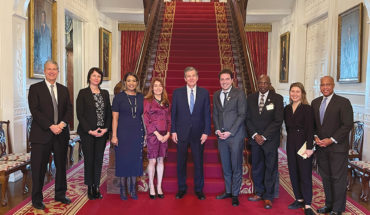
Chris and Beth Collier sit in hide-covered swivel chairs they designed; beyond lies their open dining room and kitchen.
The hospital’s second floor – which once housed patients, a delivery room, and a nurses’ station – became home.
by Liza Roberts
photographs by Catherine Nguyen
It takes a visionary to dream up things that don’t exist and make them real. It takes courage to believe in the unlikely, invest in it fully, and make it your life. And it takes love, faith, and fortitude to do it as a team. But Beth and Chris Collier of Washington, N.C. do all of that with the same refined grace they bring to design. Together they have created an avant garde furniture company in the unlikeliest of places, turned a haunted old hospital into an elegant home, and done it all while raising two boys and remaining happily wed.
The Colliers live and work in the pretty, historic town of Washington (sometimes known as “Little Washington,” incorporated in 1782; population about 10,000), which sits on the bank of the Pamlico River. The town’s inland coastal location has the breeze and spirit of the seaside, and its historic district boasts picket-fenced restored colonials and Victorians. The Colliers don’t live in one of those. Instead, they’ve made a home and workplace in a once-abandoned, 10,000-square-foot hospital, built in 1907. The Georgian pile is a place with significance for both of their families. Chris’s grandfather and great-grandfather were doctors here, and Beth’s grandmother lived here when it later served as a nursing home. Tayloe Hospital was eventually shuttered in the mid-90s, and stood empty for more than 10 years.

The second and third floors of the former Tayloe Hospital are now home to the Collier family and their design business, vanCollier.
When the Colliers came upon it in 2004, they were not concerned about the building’s ramshackle condition or the detritus left behind – beds, wheelchairs, even slippers. “We jumped in feet-first,” Chris says. It took the two of them a year and a half – and a good bit of their own elbow grease – but they turned the building into a remarkable place to work and live. The hospital’s third floor operating room became an airy studio to design, make, and finish furniture. The second floor – which once housed patients, a delivery room, and a nurses’ station – became home.
Today, a giant, creaky, original elevator moves newly finished furniture from the Colliers’ top-floor studio to their ground floor for shipping. To keep the ancient lift’s parts in working order, the couple relies on the 84-year-old repairman who first worked on the thing when its cargo was patients on gurneys, not dining chairs on pallets.
The Colliers’ work is clearly influenced by the history of their surroundings, and by the spirits that move them. Sometimes literally. They have seen a ghost more than once, and felt him, too. They expect he may once have been a cheeky doctor – possibly even a relation? – because he’s apparently fond of giving women an occasional goosey squeeze. A plaque with the name of Chris Collier’s grandfather – Dr. J. B. Hawes – sits propped on a sink, providing a possible clue.

Chris Collier’s grandfather, Dr. J. B. Hawes, worked in the building when it was a hospital. The couple found a sign with his name on it in a Washington antique shop; today it is propped casually on a sink. They joke that Dr. Hawes makes an occasional ghostly appearance and likes to give Beth the odd spectral squeeze.
But it’s the spirit of nature that originally inspired the couple’s joint designs. The first piece they designed together, a gingko-leaf-shaped sconce, was sparked in 2010 by the tree outside their window. The curvy, distinct shape of its leaves also found its way into other pieces, and has become something of an emblem for the vanCollier brand (which incorporates Beth’s maiden name of van Dorp). The tree’s budding branches are now showing up in chandeliers and table legs.
Other elements from the couple’s surroundings also play a role: Tobacco sticks Chris amassed from dismantled local tobacco barns have become recognizable vanCollier design elements, incorporated in headboards and light fixtures.

A table made of vanCollier’s emblematic gingko leaves – the inspiration for their first piece, a sconce in the same shape – awaits its final home.
Designing together was a natural evolution, they say. The two have always worked in art and design in some fashion – Chris as an antiques dealer; Beth an interior designer and museum curator. At first, their creations were custom items for Beth’s interior design clients.
But after Betty Nelson (of Eatman’s Carpets and Interiors, her family’s Raleigh business) began selling some of their pieces in her store, vanCollier’s popularity took off more broadly.
“What they do is made in North Carolina, and it’s different,” Nelson says, “…so unique and beautiful.”
Nelson says she has long considered Beth “one of the most talented people I know” with a knack for “taking something that’s kind of out-there and incorporating it into a traditional home.”
Now the brand appears poised for even bigger things: A new line the couple just designed for the major interior design company Kravet hit the market last month. Soon, furniture inspired by one Little Washington gingko tree and two creative souls will be making its way around the world.

The Colliers’ double front doors once swung open to admit patients arriving by ambulance to the former hospital. Just inside the door today is a blue-hooved pouffe covered in Tibetan wool, designed by the couple for their vanCollier line.

The living room, which once served as a nurses’ station, features paintings by the artist Marcus Reichert, whom Beth Collier represents. Antiques and contemporary designs marry effortlessly: An antique chest is topped with a vanCollier lamp; A vanCollier “Gingkie” martini table and a vanCollier candlestick are right at home with a collection of weathered walking sticks, a vanColliermirror, and an antique console table. Beth finished the floors herself with an acid stain.

Foo dog statues-turned-lamps anchor a Parsons table and two sculptures Beth made from scraps of marble. The mirror upholstered in python leather is a vanCollier design.

The kitchen’s leather bar stools with stirrups were designed by the couple; sculptures made by Beth reach for the ceiling.

Old Dutch paintings collected by Chris line the hallway connecting the kitchen to the pantry and the study beyond. Seashells and books find their way into most rooms.

A dining table is the perfect link between the Colliers’ open kitchen and living room. Candlesticks designed by the couple flank a bowl Beth made in college; the table itself was a $12 thrift-store find. A gingko table on the left holds a bounty of curly willow brought over as a gift by Chris’s mother, Mary-French Evans.

A staircase from the ground floor has bannisters made by a local hog farmer who welds in his spare time.

The main floor’s red lacquered hallway – achieved with Dutch marine paint – is a tip of the hat to celebrated interior designer Albert Hadley, whom Beth Collier reveres. This was once a hallway of patient rooms.





